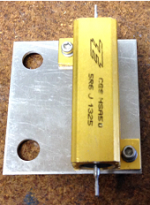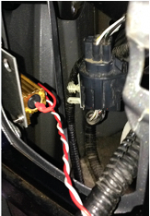mdwjeep
New member
I just checked MetalCloak's web site, and they haven't updated their installation instructions, so I'm posting this in case anyone else has the same problem I did. I've also included stock lamp data that may be generally useful in similar situations.
I purchased MetalCloak's JK ExoCorner Kit, which comes with a pair of LED tail lamps. The LED lamps caused my JK to report "tail lamp out" errors and caused the turn signals to flash rapidly. MetalCloak was unable to provide me with a solution, and I wound up having to reverse engineer both the LED lamp and the stock tail lamps to solve the problem. The problem is the LED lamps draw too little current, and the JK electrical system detects this as an error. The solution itself is simple: wire a 5.6 ohm, 50 W, resistor in parallel with the LED lamp so it draws the same current as the stock lamp.

At 12 V, a 5.6 ohm resistor dissipates 26 Watts, so I chose to use a 50 W resistor from Digikey (Digikey no. A102175-ND, mfg. no. 7-1625984-4, resistor, chassis mount, 5.6 ohm, 5%, 50 W. $4.44 each, qyt 1). The following picture shows the resistor fastened to a 2" square, 1/16" thick, Aluminum plate I purchased from Online Metals (www.onlinemetals.com). The two 5/16" holes to the left of the resistor allow the plate to slip over the 5/16-18 used to bolt the ExoCorners to the JK body.

This picture shows the heat sink plate fastened to the 5/16-18 stud just inside the tail lamp opening in the body.

How I arrived at 5.6 ohms:
I measured the LED lamp current vs. applied voltage using a variable power supply.
The LED lamp is equivalent to a 53 ohm resistor.
Likewise, I measured the stock JK tail lamp current vs. voltage.
The data only goes up to 6 V because the power supply was unable to go beyond that point. The stock lamp current vs. voltage curve has a knee at about 1V, but it is linear beyond that point. I fit the data above 1 V to a line, and evaluated the current that would be drawn at 12 V, which is 2.37 A. The effective resistance is 5 ohms.
Finally, I used the parallel resistance equation
1/Rparallel = 1/R1 + 1/R2.
The goal here is to make the parallel resistance equal to the stock lamp resistance. In this case R1, the LED lamp resistance, is 53 ohms, and Rparallel, the parallel resistance, is 5 ohms. The solution for R2, the unknown resistor, is 5.5 ohms.
The closest value I found in the Digikey catalog was 5.6 ohms. This resistor dissipates 26 W at 12 V, so I chose a 50 W resistor.
I purchased MetalCloak's JK ExoCorner Kit, which comes with a pair of LED tail lamps. The LED lamps caused my JK to report "tail lamp out" errors and caused the turn signals to flash rapidly. MetalCloak was unable to provide me with a solution, and I wound up having to reverse engineer both the LED lamp and the stock tail lamps to solve the problem. The problem is the LED lamps draw too little current, and the JK electrical system detects this as an error. The solution itself is simple: wire a 5.6 ohm, 50 W, resistor in parallel with the LED lamp so it draws the same current as the stock lamp.

At 12 V, a 5.6 ohm resistor dissipates 26 Watts, so I chose to use a 50 W resistor from Digikey (Digikey no. A102175-ND, mfg. no. 7-1625984-4, resistor, chassis mount, 5.6 ohm, 5%, 50 W. $4.44 each, qyt 1). The following picture shows the resistor fastened to a 2" square, 1/16" thick, Aluminum plate I purchased from Online Metals (www.onlinemetals.com). The two 5/16" holes to the left of the resistor allow the plate to slip over the 5/16-18 used to bolt the ExoCorners to the JK body.

This picture shows the heat sink plate fastened to the 5/16-18 stud just inside the tail lamp opening in the body.

How I arrived at 5.6 ohms:
I measured the LED lamp current vs. applied voltage using a variable power supply.
Code:
Volts Amperes
8. 0.003
8.5 0.01
9. 0.018
9.5 0.027
10 0.036
10.5 0.046
11. 0.055
11.5 0.065
12. 0.075
12.5 0.085
13. 0.095
13.5 0.105The LED lamp is equivalent to a 53 ohm resistor.
Likewise, I measured the stock JK tail lamp current vs. voltage.
Code:
Volts Amperes
0.1 0.103
0.2 0.2
0.3 0.297
0.4 0.37
0.6 0.496
0.8 0.552
1. 0.597
1.2 0.647
1.3 0.673
1.4 0.69
1.6 0.726
1.8 0.752
1.9 0.779
2. 0.796
2.1 0.814
2.2 0.82
2.3 0.836
2.4 0.857
2.5 0.88
2.6 0.881
2.7 0.901
2.8 0.928
2.9 0.946
3. 0.962
5.927 1.394The data only goes up to 6 V because the power supply was unable to go beyond that point. The stock lamp current vs. voltage curve has a knee at about 1V, but it is linear beyond that point. I fit the data above 1 V to a line, and evaluated the current that would be drawn at 12 V, which is 2.37 A. The effective resistance is 5 ohms.
Finally, I used the parallel resistance equation
1/Rparallel = 1/R1 + 1/R2.
The goal here is to make the parallel resistance equal to the stock lamp resistance. In this case R1, the LED lamp resistance, is 53 ohms, and Rparallel, the parallel resistance, is 5 ohms. The solution for R2, the unknown resistor, is 5.5 ohms.
The closest value I found in the Digikey catalog was 5.6 ohms. This resistor dissipates 26 W at 12 V, so I chose a 50 W resistor.

